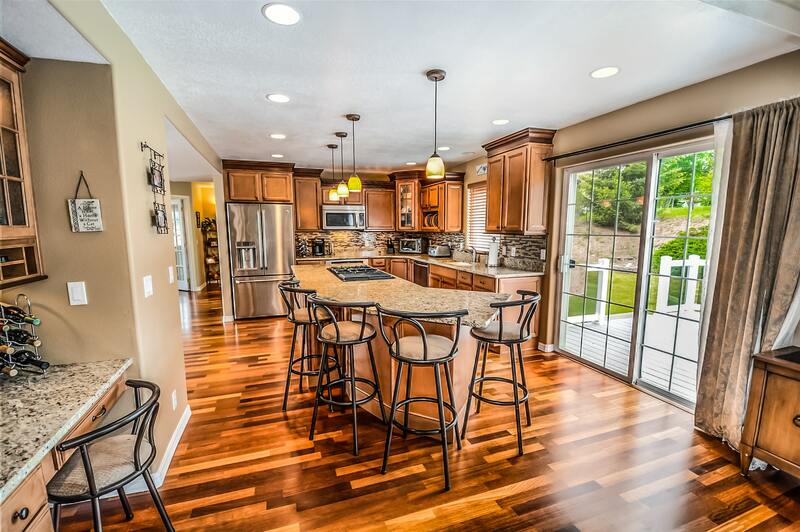Are you concerned about how to recognize water damaged hardwood floors? You have probably just experienced a flood, water leaks, or just bought a new home and want to ensure that the floor is free from water damage; whatever you have experienced, you are in an excellent place to find the answer.
Determining if your hardwood floors are water damaged and knowing the degree of the damage may help you understand if a few repairs are needed or if a full-blown replacement is required. Proceed with reading the contents below for further information.

Identifying The Signs Of Water Damage
Many factors could indicate that your hardwood floor is water damaged. You would need to look out for these indications to ensure that your base is as good as it should be.
An extended period of exposure to water might lead to softening, rotting, falling apart, or growing molds and mildew. A water damaged wood might lead to risks; hence, it is recommended to see such situations immediately.
Further, learn how you can identify water damaged hardwood floors by remembering the following and looking out for these signs:
- You might see some faded or discolored spots or areas. These stains and discolorations could indicate water damage.
- Hardwood floors often have a regular pattern of marks, and if you see irregular or faded ones, that is another sign.
- When you step on them, softened floorboards often issue a creak and are extremely unstable and unsafe to walk on. Casually pushing your hands on suspected areas can help you identify those affected.
- Notice unusually elevated spots; they might be swelling due to water absorption. Some, instead of swelling, would bend oddly.
- Another factor that may be similar or related to swelling, but instead of just a tiny spot, the floorboard might seem elevated, which is already known as cupping. It might even result in nails popping up, too; you may also want to look out for these nails, as this might cause accidental injuries.
- The growth of fuzzy or slimy discolored spots, which are molds, appears due to prolonged exposure to water.
You can also see this content about hardwood floor water damage if you’re interested.
Repairing Water Damaged Hardwood Floors
Before proceeding, you might want to consider first if you would be fixing or replacing the hardwood floors. To assess what you should do, you may refer to the following:
- How long was the floor soaked in liquid?
- What is the degree of the damage?
- Which would cost you more, fixing or replacing?
- Do you have the time to fix it by yourself?
If you decide to proceed with asking for a professionals’ assistance, you can research which business is the best and is around your area.
Now, if you can fix it by yourself, then you can see the following as a guide:
Step #1. Tidy up the area as much as possible, remove heavy furniture and pieces of equipment, and set them aside.
Step #2. Find out what caused the water damage on the hardwood floor. It might be a leaking pipe, water seeping through windows or door gaps, equipment like refrigerators and dishwashers might also be a reason.
After identifying the source, fix it immediately. So when you replace the hardwood floor, the problem wouldn’t occur again.
Step #3. Now, you’ll need to gather the tools you need: a wet vacuum, bucket, stiff brush, squeegee, rubber-gloved, dehumidifiers, and disinfectant.
Step #4. Using a wet vacuum, slowly go over the wet areas. Use a squeegee to gather moisture, then let the wet vacuum suck up the water.
Step #5. Clean the hardwood floor with mild detergent, disinfectant, and warm water solution. Dip the brush into the mixture, then scrub the floor.
There is no need to pour water after applying the mixture, as this might cause further damage. Ensure that you’ve scrubbed the floor thoroughly; this is also to prevent the growth of molds and mildew.
To learn how you can deal with mold growths, you may visit this article titled how to remove mold from wood floors.
Step #6. Leave a dehumidifier in the room to ensure that it would slowly suck the moisture out from the wood. Impatiently using direct heat might cause more damage.
If you don’t have a dehumidifier, and if the weather is not humid, you can open doors and windows for good airflow. Run a fan to assist the drying process too.
Step #7. You can resolve a slightly elevated wood by patiently sanding it. As this process might be too demanding, you can ask for an experienced person’s help for this one.
In some cases, changing a few planks of wood are feasible and a much better option for a smaller area but heavily damaged ones. For assistance on this task, you might want to visit this content on how to replace damaged areas of hardwood flooring.
Step #8. You can now proceed to refurbish your hardwood floor. Whether you’ll repaint or refinish it, first apply a sealant.
You might also want to see this article concerning how to clean water damaged wood base.
Conclusion
Regarding how to recognize water damaged hardwood floors, you’ll only need to remember six signs. Hopefully, you’ll find this article helpful!
